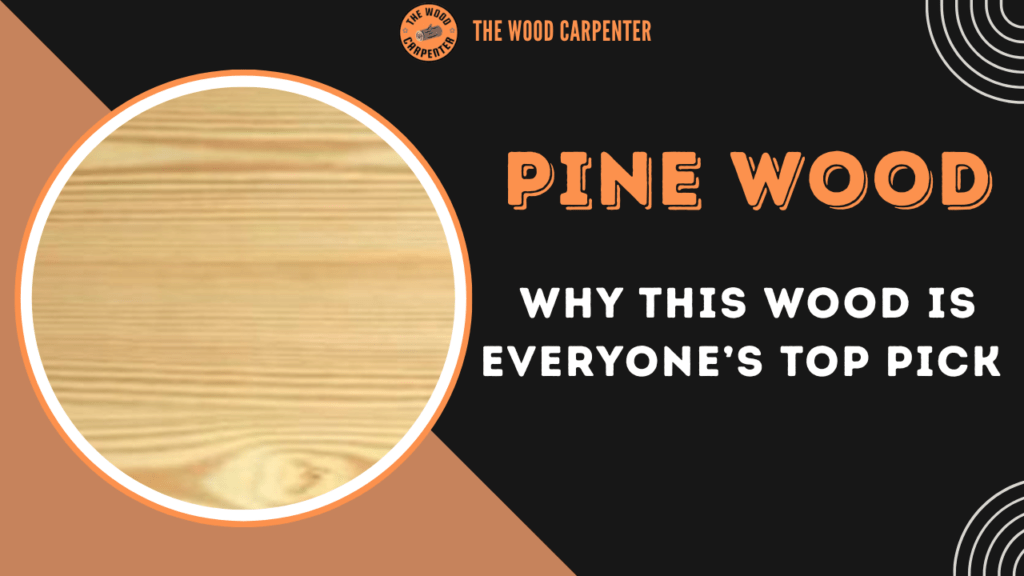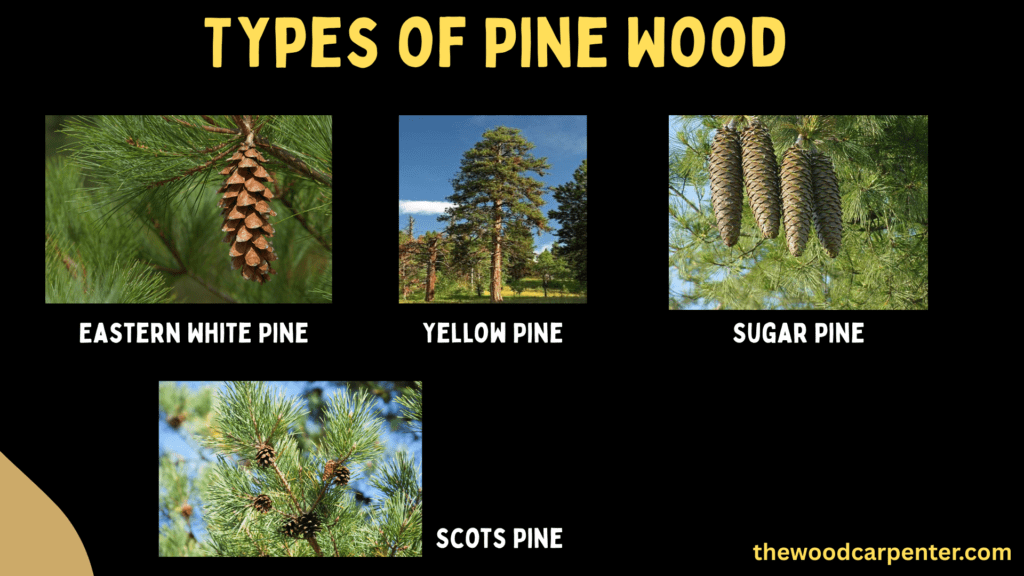
Pine wood is one of the most widely used and loved types of wood in the world. You’ll find it in everything from furniture and floors to buildings and decorations. People like it because it’s affordable, easy to work with, and has a warm, natural look. Whether you’re a DIY enthusiast, a carpenter, an architect, or an homeowner then pine wood is often a go-to choice.
This full guide will help you understand all about pine wood—where it comes from, what it’s like, how it’s used, its pros and cons, whether it’s eco-friendly, and answers to common questions.
What is Pine Wood ?
Pine wood comes from pine trees, which belong to the Pinus group, a part of the conifer tree family. There are more than 120 different types of pine trees found around the world. These trees grow quickly, stay green all year, and are mostly found in the Northern Hemisphere, although many are also grown in plantations worldwide.
Pine wood comes in several types, and it’s usually divided into two main groups:
Hard pines – These include species like Yellow Pine and Longleaf Pine. They are denser and have a tighter grain pattern.
Douglas Fir vs Yellow Pine: Finding the Perfect One
Soft pines – These include species like Sugar Pine and Eastern White Pine. They are lighter and have a softer, more open grain.
The difference between hard and soft pines mostly depends on how dense the wood is and what the grain looks like. Both types are used in different ways depending on the project needs.
Types of Pine Wood

Pine wood comes from different species of pine trees, and each type has its own unique qualities. These differences make certain types better suited for specific uses. Here are some of the most common kinds:
Eastern White Pine
This is a soft, light-colored wood often used for making furniture and indoor wall paneling. It’s easy to work with and has a smooth finish.
Yellow Pine
This type is harder and stronger than most pines. It’s great for flooring and building structures because it can handle more weight and pressure.
Sugar Pine
Known for its straight grain and smooth texture, sugar pine is easy to work with. That’s why it’s often chosen for cabinets and detailed woodworking.
Scots Pine
Originally from Europe, Scots Pine is strong and durable. It’s commonly used for heavy-duty furniture and construction work.
Physical Characteristics of Pine Wood
Color and Grain
Pine wood usually comes in soft colors like creamy white, pale yellow, or light brown. The outer part of the tree (called sapwood) is lighter in color, while the inner part (called heartwood) can be light brown or reddish.
Pine often has a straight grain with visible knots, which gives it a natural, rustic look. Some types of pine also have noticeable resin lines that add to the wood’s character and visual appeal.
Also read:
Why Thuya Wood is the Ultimate Choice for Luxury Projects!
Bocote Wood: Pros and Cons That Might Surprise You
Hardness and Density
Pine is a softwood, so it’s not as hard or dense as many hardwoods. Its hardness level (measured by the Janka scale) usually falls between 380 and 870 pounds-force, depending on the species. That’s much softer than woods like oak or maple.
Its density is generally between 400 and 600 kg per cubic meter. This means pine is lightweight, easy to carry, and cheaper to transport.
Workability
One of the best things about pine is how easy it is to work with. You can easily:
- Cut it
- Nail or screw into it
- Glue pieces together
- Smooth it out with a plane
- Carve it for detail
Because of this, pine is a top choice for many projects—whether you’re building big beams or making decorative furniture. It also takes paint, stain, and clear finishes very well. This makes it flexible for different styles, from rustic to modern.
Advantages and Disadvantages
Advantages of Pine Wood
Affordable:
Pine is one of the cheapest woods available. It grows quickly and is easy to find, which helps keep the cost low.
Easy to Work With:
Pine is simple to cut, shape, join, and finish. It’s great for both beginners and skilled woodworkers.
Very Versatile:
Pine is used in many things—like building frames, floors, furniture, doors, windows, packaging, and even paper products.
Eco-Friendly:
Most pine used in the market is grown in managed plantations. This makes it a renewable resource when harvested responsibly.
Disadvantages of Pine Wood
Softness:
Pine is softer than many of the hardwoods, so it dents and scratches more easily—especially in the busy areas or on heavily used furniture.
Knots in the Wood:
Pine often has visible knots. While they add a natural charm, knots can sometimes weaken the wood or affect how it looks and works.
Not Very Durable Outdoors:
Pine doesn’t naturally resist rot or insects very well. It needs to be pressure-treated or sealed properly to be used outside or in wet conditions.
Main Uses of Pine Wood
Furniture:
Pine is popular for making beds, tables, shelves, dressers, and other home furniture. It’s especially common in rustic, farmhouse, and Scandinavian designs. Its light color and natural grain look good with many types of finishes.
Flooring:
Pine flooring adds a warmth and a natural look to homes— especially in cottages or country-style interiors. Though it is softer than oak or maple, pine floors they develop a rich, aged look over time.
Construction:
Pine is often used in house framing, beams, roof structures, paneling, and under-flooring. Its strength compared to its weight makes it a good building material.
Doors and Windows:
Treated pine is used for making door and window frames, trim, and sills.
Decorative Work and Millwork:
Pine is great for wall panels, moldings, ceiling beams, and carved or turned wood details.
Other Uses:
Pine is also used for making plywood, veneer, fences, decks (when treated), poles, crates, boxes, and even paper pulp.
Pine Species: A Closer Look
Pine wood comes in two main types, based on how dense and strong the wood is:
Hard Pines:
These are the strongest and heaviest pines. They have a clear difference between the lighter and darker parts of the growth rings, giving them a bold, noticeable grain.
Examples: Yellow Pine, Longleaf Pine, Loblolly Pine.
Soft Pines:
These are lighter in weight and have a finer, smoother grain. They look more even and are easier to work with.
Examples: Eastern White Pine, Sugar Pine, Western White Pine.
Each type of pine has its own color, strength, and best uses. Some are better for building, while others are perfect for furniture or crafts.
Sustainability and Environmental Impact
Pine trees grow quickly. In some places, they can be ready to harvest in just 20–30 years. This fast growth means we can keep planting and using pine without harming natural forests.
To make sure the wood is harvested in a responsible way, look for certifications like FSC (Forest Stewardship Council). Using pine from well-managed plantations helps protect the environment and supports eco-friendly forestry.
Maintenance and Care
- To keep pine looking good and lasting long, it needs some protection and care:
- Seal or finish the wood to help protect it from moisture, scratches, and stains.
- Clean it regularly, fix dents or scratches quickly, and use floor pads or rugs in busy areas to prevent damage.
- For outdoor use, only use pine that’s been pressure-treated or chemically treated to prevent rot and insect damage.
Frequently Asked Questions (FAQs)
Q: Is pine wood good for furniture?
A: Yes! Pine is often used for furniture because it’s affordable, easy to work with, and has a nice natural grain. It’s best for pieces that won’t be heavily used, like bedroom or living room furniture. Since it’s soft, you’ll need to be careful with furniture that gets a lot of wear.
Q: Can pine be used outdoors?
A: Untreated pine should not be used outdoors. But pressure-treated pine is great for things like decks, fences, and outdoor frames because it can resist moisture, rot, and bugs.
Q: Is pine better than hardwood for some projects?
A: Pine is lighter, cheaper, and easier to cut than most hardwoods. It’s great for interior trim, simple furniture, and building projects. But it’s not as hard or long-lasting as hardwoods like oak, maple, or walnut for things like flooring or heavy-use furniture.
Q: Can pine warp or shrink?
A: Pine usually holds its shape well, but it can still warp or shrink if it isn’t properly dried or finished. To prevent this, keep it sealed and avoid big changes in humidity.
Q: What finishes work well on pine?
A: Pine can be stained, painted, oiled, or varnished. However, it can absorb stain unevenly, so using a pre-stain wood conditioner helps get a smoother result.
Q: Is pine environmentally friendly?
A: Yes. Most pine is grown in plantations, making it a renewable resource. Always choose certified pine for guaranteed sustainability.
Q: Why is pine cheaper than other types of wood?
A: Pine is grown in many places around the world. It grows quickly and is easy to cut and process, which helps keep costs low.
Final Thoughts
Pine wood is popular because it’s affordable, easy to work with, and has a natural, rustic charm. Its wide range of uses—from furniture and floors to construction and decoration—makes it a favorite for both professionals and hobbyists.
Since it grows quickly and can be farmed responsibly, pine is also an environmentally friendly option. When cared for properly, pine wood can last for many years and bring warmth and beauty to your home or project.
.

